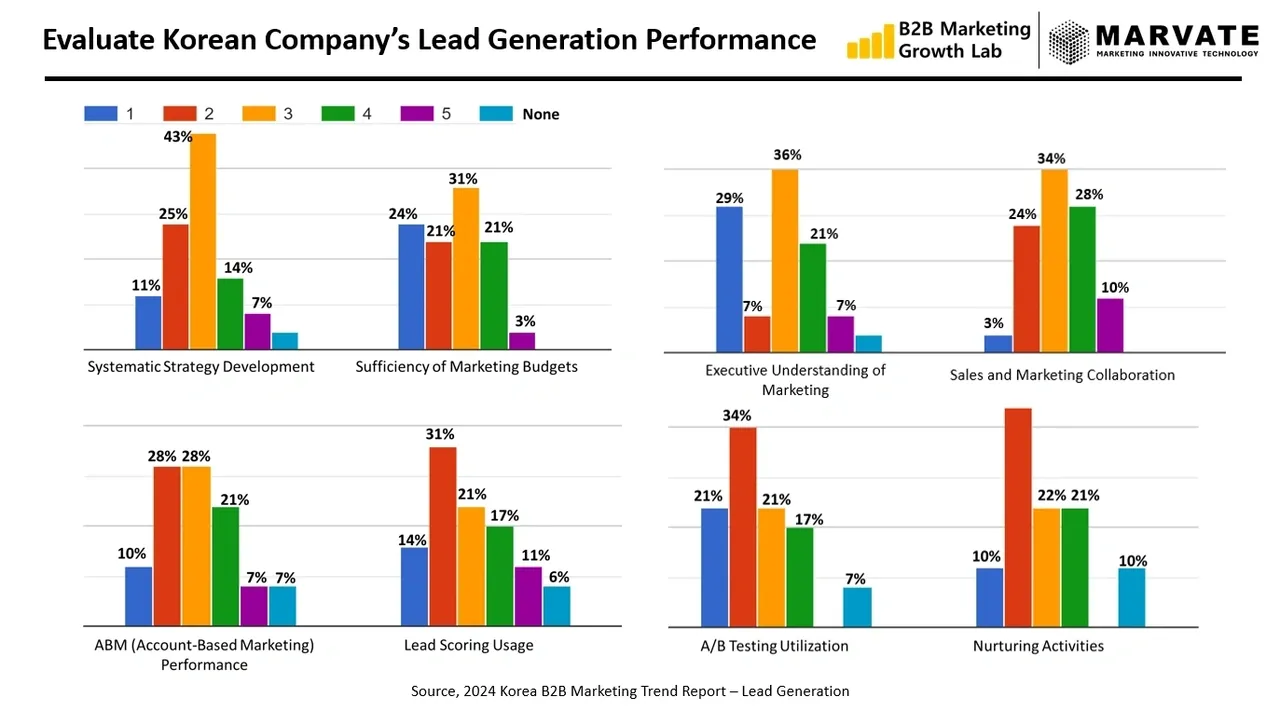Evaluate Korean Company’s Lead Generation Performance

🔍 Key Findings
- Systematic Strategy Development
- Only 21% of companies systematically establish lead generation strategies.
- 43% responded that their strategy development is "average," while 36% rated it as "below average."
- The gap between global companies and domestic companies in this area was not significant.
- The lack of a systematic strategy places additional pressure on marketing employees, negatively impacting productivity and job satisfaction.
2. Sufficiency of Marketing Budgets
- Only 24% of companies allocate sufficient budgets for lead generation.
- 31% rated their budget as "average," while 45% believed their budget was "insufficient."
- The survey suggests that to achieve proper growth in lead generation, at least 50% of companies should have adequate marketing budgets.
3. Executive Understanding of Marketing
- 64% of executives have an "above-average" understanding of marketing, suggesting that senior leaders recognize the importance of marketing.
- However, 36% still have a "below-average" understanding, with 29% of these respondents also lacking a systematic strategy for lead generation.
- This highlights a direct link between executive understanding of marketing and the company's ability to develop a structured strategy.
4. Sales and Marketing Collaboration
- 73% of respondents believe that collaboration between sales and marketing is "average" or "above average."
- Only a small percentage indicated that collaboration was "very poor," suggesting that the relationship between sales and marketing is relatively positive.
- Companies with poor collaboration may still view marketing as a support function for sales rather than a core driver of revenue.
5. A/B Testing Utilization
- 62% of companies do not actively perform A/B testing as part of their lead generation strategy.
- Companies are encouraged to implement more A/B testing as it is a powerful tool for optimizing lead generation.
- The survey suggests that increasing the adoption of A/B testing from 38% to 50% could make A/B testing a mainstream practice in Korea’s B2B marketing landscape.
6. Nurturing Activities
- 58% of companies do not conduct nurturing activities effectively, similar to previous survey findings from the 2024 Korea B2B Marketing Nurturing Trend Report.
- A significant number of companies with ineffective nurturing programs have fewer than 3 marketers on their teams, suggesting that a lack of manpower is a key factor.
- Companies must improve awareness and methods for nurturing to build more effective lead generation programs.
7. ABM (Account-Based Marketing) Performance
- 28% of companies are successful in using ABM for lead generation, while 28% perform at an average level.
- However, 45% of companies do not execute ABM effectively, with challenges in strategy, account management, and onsite seminar execution.
- While digital ABM campaigns can still generate opportunities, most onsite ABM initiatives are driven by sales teams, which could limit the role of marketing.
8. Lead Scoring Usage
- 51% of companies do not use lead scoring effectively.
- Lead scoring requires marketing automation or CRM platforms, but many companies continue to rely on Excel, which has limitations when dealing with large datasets.
- Companies are encouraged to implement lead scoring as a key performance indicator to track the growth and potential of leads, as well as the need for additional nurturing activities.

📊 Analysis & Insights
- Urgent Need for Systematic Strategy Development
- Only 21% of companies have a systematic strategy for lead generation, which is consistent with global trends but still too low.
- Companies lacking a structured strategy tend to face challenges with marketing execution, resulting in low productivity and employee dissatisfaction.
- There is a strong correlation between executive understanding of marketing and a company's ability to develop a systematic strategy. Companies with executives who have limited marketing knowledge are less likely to have a solid lead generation strategy.
2. Budget Constraints are a Major Bottleneck
- Only 24% of companies have sufficient budgets for lead generation.
- Insufficient budget allocation can limit investment in key areas like content creation, nurturing programs, and ABM, all of which are essential for effective lead generation.
- To see significant improvement, at least 50% of companies should secure sufficient budgets, especially as lead generation becomes more data-driven and dependent on paid media, CRM systems, and automation tools.
3. Marketing and Sales Alignment is Improving
- The survey shows that 73% of companies report "average or better" collaboration between sales and marketing.
- However, some companies still see marketing as a "support function" for sales rather than a strategic partner.
- For full sales-marketing alignment, it is essential to move away from the traditional sales-dominated approach and embrace harmonized account-based revenue models.
4. Need for Broader Adoption of A/B Testing
- With 62% of companies not fully utilizing A/B testing, there is a missed opportunity for continuous improvement.
- A/B testing should be used to optimize website CTAs, email campaigns, and lead form designs, all of which play a critical role in lead generation.
- Increasing A/B testing adoption from 38% to 50% will establish a better "test and learn" culture in Korea’s B2B marketing.
5. Nurturing Capabilities Must be Strengthened
- 58% of companies report that nurturing programs are underperforming, and this issue is compounded by a lack of manpower.
- Since companies with fewer than 3 marketers on staff struggle with nurturing, it is vital to automate nurturing activities and leverage marketing automation platforms to fill the gap.
- Companies should focus on drip campaigns, lead scoring, and personalized content delivery to drive improvements in nurturing performance.
6. Account-Based Marketing (ABM) is Underutilized
- 28% of companies effectively execute ABM, but 45% still face significant challenges.
- A lack of onsite seminars and difficulties with account prioritization are notable barriers.
- To improve, companies should build digital-first ABM programs that leverage intent data, targeted ad campaigns, and personalized outreach to overcome these hurdles.
7. Lead Scoring is Underused
- With 51% of companies not effectively utilizing lead scoring, there is a clear opportunity for improvement.
- Implementing lead scoring requires marketing automation platforms (like HubSpot or Salesforce) instead of manual Excel tracking.
- By using lead scoring, companies can track lead quality and prioritize which leads to nurture or convert. This can significantly increase sales-qualified leads (SQLs) and drive better sales outcomes.
🧭 Recommendations
- Support Strategy Development
- Provide standardized frameworks and templates for lead generation strategy development.
- Offer executive workshops to improve C-suite understanding of marketing, which is directly linked to better strategy execution.
- Encourage companies to develop a structured approach to lead nurturing and lead scoring.
2. Increase Budget Allocation
- Raise awareness of the importance of marketing investment, especially for ABM, nurturing, and automation.
- Highlight the ROI potential of higher budget allocation.
- Support companies in identifying cost-effective lead generation strategies that require less budget but produce high impact, such as content marketing.
3. Enhance Sales-Marketing Alignment
- Foster alignment through joint workshops for marketing and sales teams.
- Implement shared KPIs and dashboards to promote visibility and accountability.
- Shift the perception of marketing from a "support function" to a revenue-generating team.
4. Automate Lead Nurturing
- Invest in automation platforms (like HubSpot or Marketo) to automate nurturing workflows.
- Use drip campaigns and personalized email sequences to guide leads through the funnel.
- Encourage companies to track engagement with content to trigger personalized follow-ups.
5. Expand Use of A/B Testing
- Teach companies how to run A/B tests on email campaigns, landing pages, and CTAs.
- Encourage a "test and learn" culture where every campaign includes an A/B testing component.
- Companies with fewer resources should focus on small, quick tests to optimize lead conversion.
6. Embrace Data-Driven ABM
- Encourage companies to develop digital-first ABM strategies to overcome challenges with onsite events.
- Utilize intent data and predictive analytics to prioritize target accounts.
Please contact us for your ABM and Lead Generation campaign for the Korean and global markets.
Eddy Kim